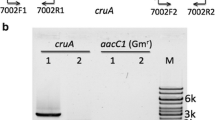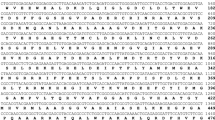Abstract
Chlorophyll-b-possessing cyanobacteria of the genus Prochlorococcus share the presence of high amounts of α- and β-carotenoids with green algae and higher plants. The branch point in carotenoid biosynthesis is the cyclization of lycopene, for which in higher plants two distinct enzymes are required, ε- and β-lycopene cyclase. All cyanobacteria studied so far possess a single β-cyclase. Here, two different Prochlorococcus sp. MED4 genes were functionally identified by heterologous gene complementation in Escherichia coli to encode lycopene cyclases. Whereas one is both functionally and in sequence highly similar to the β-cyclase of Synechococcus sp. strain PCC 7942 and other cyanobacteria, the other showed several intriguing features. It acts as a bifunctional enzyme catalyzing the formation of ε- as well as of β-ionone end groups. Expression of this cyclase in E. coli resulted in the simultaneous accumulation of α- β-, δ-, and ε-carotene. Such an activity is in contrast to all lycopene ε-cyclases known so far, including those of the higher plants. Thus, for the first time among prokaryotes, two individual enzymes were identified in one organism that are responsible for the formation of cyclic carotenoids with either β- or ε-end groups. These two genes are suggested to be designated as crtL-b and crtL-e. The results indicate that both enzymes might have originated from duplication of a single gene. Consequently, we suggest that multiple gene duplications followed by functional diversification resulted several times, and in independent lineages, in the appearance of enzymes for the biosynthesis of cyclic carotenoids.





Similar content being viewed by others
Abbreviations
- Chl :
-
Chlorophyll
- CPDMA :
-
2-(4-Chlorophenylthio)-dimethylethylamine
References
Böger P, Sandmann G (1998) Carotenoid biosynthesis inhibitor pesticides—mode of action and resistance mechanisms. Pesticide Outlook 9:29–35
Borokov AY, Rivkin MI (1997) XcmI-containing vector for direct cloning of PCR products. BioTech 22:821–814
Breitenbach J, Braun G, Steiger S, Sandmann G (2001a) Chromatographic performance on a C30-bonded stationary phase of mono hydroxycarotenoids with variable chain length or degree of desaturation and of lycopene isomers synthesized by different carotene desaturases. J Chromatogr A 936:59–69
Breitenbach J, Vioque A, Sandmann G (2001b) Gene sll0033 from Synechocystis 6803 encodes a carotene isomerase involved in the biosynthesis of all-E lycopene. Z Naturforsch [C] 56:915–917.
Cunningham FX, Gantt E (2001) One ring or two? Determination of ring number in carotenoids by lycopene epsilon-cyclases. Proc Natl Acad Sci U S A 98:2905–2910
Cunningham FX, Sun Z, Chamovitz D, Hirschberg J, Gantt E (1994) Molecular structure and enzymatic function of lycopene cyclase from the cyanobacterium Synechococcus sp strain PCC7942. Plant Cell 6:1107–1121
Cunningham FX, Pogson B, Sun Z, McDonald KA, DellaPenna D, Gantt E (1996) Functional analysis of the beta and epsilon lycopene cyclase enzymes of Arabidopsis reveals a mechanism for control of cyclic carotenoid formation. Plant Cell 8:1613–1626
Goericke R, Repeta DJ (1992) The pigments of Prochlorococcus marinus : the presence of divinyl chlorophyll a and b in a marine prochlorophyte. Limnol Oceanogr 37:425–433
Goericke R, Olson RJ, Shalapyonok A (2000) A novel niche for Prochlorococcus sp in low-light suboxic environments in the Arabian Sea and the Eastern Tropical North Pacific. Deep Sea Res Pt I Oceanog Res 47:1183–1205
Hess WR, Rocap G, Ting C, Larimer F, Lamerdin J, Stilwagon S, Chisholm SW (2001) The photosynthetic apparatus of Prochlorococcus: Insights through comparative genomics. Photosynth Res 70:53–72
Krubasik P, Sandmann G (2000a) A carotenogenic gene cluster from Brevibacterium linens with novel lycopene cyclase genes involved in the synthesis of aromatic carotenoids. Mol Gen Genet 263:423–432
Krubasik P, Sandmann G (2000b) Molecular evolution of lycopene cyclases involved in the formation of carotenoids with ionone end groups. Biochem Soc Trans 28:806–810
Masamoto K, Wada H, Kaneko T, Takaichi S (2001) Identification of a gene required for cis-to-trans carotene isomerization in carotenogenisis of the cyanobacterium Synechocystis sp. PCC6803. Plant Cell Pysiol 42:1398–1402
Miyashita H, Adachi K, Kurano N, Ikemoto H, Chihara M, Miyachi S (1997) Pigment composition of a novel oxygenic photosynthetic prokaryote containing chlorophyll d as the major chlorophyll. Plant Cell Physiol 38:274–281
Moore LR, Goericke R, Chisholm SW (1995) Comparative physiology of Synechococcus and Prochlorococcus: influence of light and temperature on growth, pigments, fluorescence and absorptive properties. Mar Ecol Prog Ser 116:259–275
Partensky F, Hoepffner N, Li WKW, Ulloa O, Vaulot D (1993) Photoacclimation of Prochlorococcus sp (Prochlorophyta) strains isolated from the North Atlantic and the Mediterranean Sea. Plant Physiol 101:295–296
Partensky F, Hess WR, Vaulot D (1999) Prochlorococcus, a marine photosynthetic prokaryote of global significance. Microbiol Mol Biol Rev 63:106–127
Pennington FC, Haxo FT, Gorch G, Liaaen-Jensen S (1985) Carotenoids of cryptophyceae. Biochem Syst Ecol 13:215–219
Pinevich AB, Velichko NB, Bazanova AV (2000) Prochlorophytes twenty years on. Russ J Plant Physiol 47:639–643
Rudi K, Skulberg OM, Larsen F, Jakobsen KS (1997) Strain characterization and classification of oxyphotobacteria in clone cultures on the basis of 16S rRNA sequences from the variable regions V6, V7, and V8. Appl Environ Microbiol 63:2593–2599
Sambrook J, Fritsch EF, Maniatis T (1989) Molecular cloning. a laboratory manual. Cold Spring Harbor Laboratory, Cold Spring Harbor, New York
Sandmann G (1994) Carotenoid biosynthesis in microorganisms and plants. Eur J Biochem 223:7–24
Sandmann G (2001) Carotenoid biosynthesis and biotechnological application. Arch Biochem Biophys 385:4–12
Sandmann G (2002) Combinatorial Biosynthesis of carotenoids in a heterologous host: a powerful approach for the biosynthesis of novel structures. ChemBioChem 3:629–635
Sandmann G, Vioque A (1999) Phylogeny of carotenogenic genes and enzymes in cyanobacteria. In: Peschek GA, Löffelhardt W, Schmetterer G (eds) The phototrophic prokaryotes. Kluwer Academic, New York, pp 799–803
Schnurr G, Misawa N, Sandmann G (1996) Expression, purification and properties of the lycopine cyclase from Erwinia uredovora. Biochem J 315:869–874
Strimmer K, von Haeseler A (1996) Quartet puzzling: a quartet maximum likelihood method for reconstructing tree topologies. Mol Biol Evol 13:964–969
Swofford DL (2000) PAUP*. Phylogenetic analysis using parsimony (*and other methods). Sinauer Associates, Sunderland, Massachusetts
Thompson JD, Higgins DG, Gibson TJ (1994) CLUSTAL W: improving the sensitivity of progressive multiple sequence alignment through sequence weighting, positions-specific gap penalties and weight matrix choice. Nucleic Acids Res 22:4673–4680
Verdoes J, Krubasik P, Sandmann G, van Ooyen M (1999) Isolation and functional characterisation of a novel type of carotenoid biosynthetic gene from Xanthophyllomyces dendrorhus. Mol. Gen Genet 262:453–461
Acknowledgements
We thank F. Larimer, S. Stilwagon and S. W. Chisholm for access to the preliminary sequence data for Prochlorococcus strains MED4 and MIT 9313, obtained from the DOE Joint Genome Institute (JGI) at http://www.jgi.doe.gov/JGI_microbial/html/prochlorococcus/prochlo_pickastrain.html. Supported by the EU program MARGENES (QLRT-2001-01226) and grant SFB 429-TP A4 from the Deutsche Forschungsgemeinschaft, Bonn, to WRH.
Author information
Authors and Affiliations
Corresponding author
Rights and permissions
About this article
Cite this article
Stickforth, P., Steiger, S., Hess, W.R. et al. A novel type of lycopene ε-cyclase in the marine cyanobacterium Prochlorococcus marinus MED4. Arch Microbiol 179, 409–415 (2003). https://doi.org/10.1007/s00203-003-0545-4
Received:
Revised:
Accepted:
Published:
Issue Date:
DOI: https://doi.org/10.1007/s00203-003-0545-4




